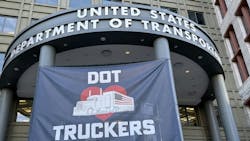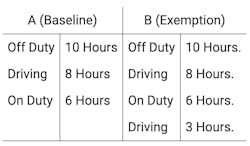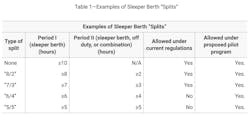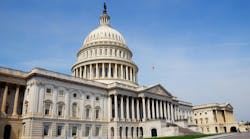FMCSA outlines HOS exemption pilots to test driver flexibility
Key takeaways
- FMCSA is developing two pilot programs to test increased HOS flexibility for truck drivers: driving time pauses and sleeper berth split options.
- Drivers will be monitored via smartphones, smartwatches, telematics, and surveys.
- The program aims to determine if flexible HOS rules can reduce fatigue, improve driver safety, and mitigate traffic congestion and detention times.
The Federal Motor Carrier Safety Administration (FMCSA) is another step closer to loosening its hours of service (HOS) requirements. FMCSA published its proposed HOS pilot programs in the Federal Register this week, outlining in greater detail what the pilots could look like.
The agency is developing two pilot programs that allow fleets and drivers more HOS flexibility: one allowing drivers to pause their 14-hour driving window and one to split their sleeper berth time. These programs were first announced as part of the Pro-Trucker Package in June.
The agency said the pilots will help it determine if greater HOS flexibility can reduce fatigue and improve safety.
“Truck drivers are the backbone of our economy, and we owe it to them to explore smarter, data-driven policies that make their jobs safer and more enjoyable,” said Secretary of Transportation Sean Duffy. “These pilot programs will help identify real solutions for America’s drivers without compromising safety.”
Pilot 1: Pausing the 14-hour driving limit to reduce detention time and improve driver efficiency
Current HOS regulations put a hard limit on driving after 14 hours since coming on duty. The split duty period program would allow commercial motor vehicle (CMV) drivers an option to extend their 14-hour driving window by pausing their driving time.
The pause, FMCSA now confirms, could include detention time. The driving pause period could be anywhere between 30 minutes and three hours.
“FMCSA believes that the exemption covered by the proposed pilot program provides the flexibility to take extra rest, avoid driving during traffic congestion, and mitigate the impacts of unreasonable ‘detention times,’ thereby improving the working conditions of America’s truck drivers,” the agency said in the Federal Register.
Pilot 2: New sleeper berth split rules to optimize rest breaks and fleet scheduling
Current HOS rules also require a 10-hour off-duty period each day. That period can be 10 hours consecutively or split into two separate periods, where the first period is at least seven hours and the second at least two hours. These periods can include 7/3 or 8/2 splits.
FMCSA’s flexible sleeper berth program would allow participating drivers to divide their sleeper berth time into other configurations, such as 6/4 or 5/5 splits.
Splitting someone’s daily sleep into two periods is known as biphasic sleeping, a practice that was common in winters before the industrial revolution. In its proposal, FMCSA referenced several independent and sponsored studies that suggest multi-phased sleep might not make drivers significantly more fatigued.
Fleet participation requirements for FMCSA HOS pilot exemption programs
FMCSA is limiting participation to 256 CMV drivers for either program (a maximum of 512 drivers combined).
The pilots would take about 34-36 months to complete. Each driver would submit data for four months—one month to collect baseline data and three months using the exemption.
Participating carriers would submit application information for a pre-study briefing. The agency requires that participating carriers not have:
- a high or moderate risk crash rate,
- a conditional or unsatisfactory safety rating,
- any enforcement actions within the past three years,
- a driver out of service (OOS) rate above 5.97%, or
- a vehicle OOS rate above 21.41%.
FMCSA would provide its eligible participants’ drivers with a smartphone and smartwatch to monitor health information, including fatigue, alertness, and rest cycles. The agency would also collect data from telematics, surveys, electronic logging devices, external cameras, and inspections.
FMCSA would share the names of participating motor carriers publicly online but would keep driver information private. The agency would keep its collected data confidential even from the carrier.
Fleets small and large, as well as owner-operators, will likely participate in the program. To apply, fleets and drivers would complete an online application at the pilot program’s website.
Next steps for FMCSA HOS exemption pilots and implications for fleet operations
FMCSA is accepting comments on its proposed programs until November 17. Industry stakeholders can submit comments on either pilot through the Federal Register. FMCSA is requesting industry thoughts on additional safeguards, types of data, relevant factors, and more.
After the comment period closes, FMCSA will publish a final rule some undetermined months later, likely announcing the program’s timeline.
If the programs’ data makes a persuasive case for more flexible HOS exemptions, these driver regulations may be relaxed in a few years.
About the Author
Jeremy Wolfe
Editor
Editor Jeremy Wolfe joined the FleetOwner team in February 2024. He graduated from the University of Wisconsin-Stevens Point with majors in English and Philosophy. He previously served as Editor for Endeavor Business Media's Water Group publications.





